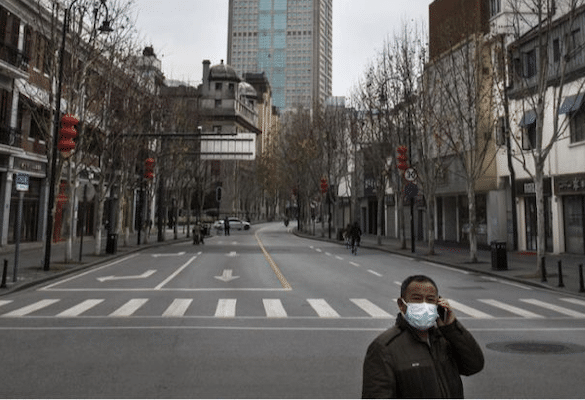FAIR has criticized the plausibility of various origin theories regarding COVID-19 (4/17/20, 5/7/20), and of unfounded allegations of a Chinese cover-up laundered by corporate media (4/2/20, 4/9/20). Other persistent myths are allegations of Chinese manipulation of the World Health Organization (WHO), and blaming Chinese secrecy for the lack of early action on containing the coronavirus.
The Trump administration suspended funding to WHO in April—the UN’s primary infectious disease–fighting body—accusing it of “severely mismanaging and covering up the spread of the coronavirus,” and of taking China’s allegedly deceptive claims about its handling of COVID-19 at “face value.” But corporate media had already been boosting these same talking points.
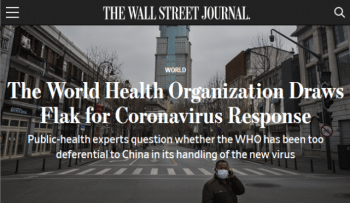
The Wall Street Journal (2/12/20) reports that “the WHO has rarely had to deal with an entity as politically and economically powerful as China today”—other than the U.S. from 1948–2014, of course.
The Wall Street Journal’s “The World Health Organization Draws Flak for Coronavirus Response” (2/12/20) effectively accused WHO of being “too deferential to China in its handling of the new virus,” and criticized WHO Director-General Tedros Ghebreyesus for “bending to Beijing” after lauding China’s unquestionably effective swift quarantine of 60 million people, and for declaring that “China is actually setting a new standard for outbreak response” and identifying the virus in “record time.” The Journal further expounded the conspiracy theory of a seemingly omnipotent China having WHO under its thumb:
Over its decades of battling epidemics, the WHO has rarely had to deal with an entity as politically and economically powerful as China today. It can’t afford to alienate the country’s leadership, whose clout and financial largess it aims to attract to global health causes. It needs Beijing’s cooperation in preventing a full-blown pandemic—and this may not be the last time. China is the source of many emerging pathogens, which jump from animals to humans in its teeming live markets and can cause deadly epidemics.
According to the Journal’s logic, when WHO praises China for an effective response containing COVID-19 and giving the rest of the world ample time to take health precautions, it is “compromising its own epidemic response standards, eroding its global authority, and sending the wrong message to other countries that might face future epidemics.” When Dr. Bruce Aylward—a Canadian medical expert with 30 years of experience combating polio, Ebola and other global health emergencies—concluded that he “didn’t see anything that suggested manipulation of numbers,” after leading a team of experts visiting China for WHO, that can’t be an accurate observation. For corporate journalists, it can only be because he was duped by the devious Chinese government “underreporting both total cases and deaths it’s suffered from the disease” (Bloomberg, 4/1/20).
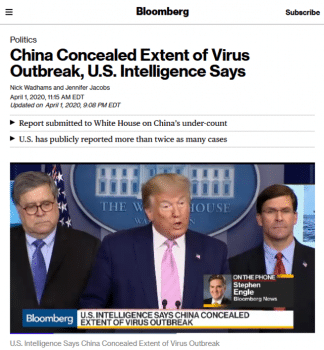
Bloomberg (4/1/20): “The officials asked not to be identified because the report is secret, and they declined to detail its contents.” But trust us—China is not being transparent!
The Journal flimsily explained that China wields such formidable control over the WHO because China is a “future source of funds and a partner with which to tackle the biggest global health problems,” and not as a “current donor.” That would be because a cursory examination of WHO’s funding would reveal that the U.S. donated more than 10 times more money to WHO ($893 million) than China ($86 million), despite the U.S. having almost $200 million in arrears before suspending payments (Axios, 4/15/20).
Neither does the Journal explain how or why WHO could possibly withhold information from Western nations even if it wanted to, when its leadership is stacked with Americans and Europeans, and 15 U.S. officials were embedded with the WHO in Geneva, given that the U.S. is the most “politically and economically powerful” nation on Earth. This makes the Trump administration’s declaration of the U.S. terminating its membership in WHO after threats to permanently cut funding especially egregious.
Nor can the Journal explain the source of China’s fearsome influence over independent and prestigious medical journals like Nature (5/4/20), Science (3/28/20) and the Lancet (3/7/20), which also credited the effectiveness and transparency of China’s response for saving thousands of lives (CGTN, 5/1/20, 5/10/20). Does China’s mysterious and awe-inspiring influence extend over Western medical journals as well?
When Foreign Policy (5/12/20) reported on the exclusive scoop of a leaked dataset of coronavirus cases and deaths from the Chinese military’s National University of Defense Technology, it confirmed that the leaked information “matches” the publicly available numbers the Chinese government posts online—which poses an inconvenience to those spouting conspiracy theories of a Chinese government coverup. Corporate media accounts of Chinese deception and fake statistics also fail to explain how the Chinese government possesses the fantastical ability to deceive governments and independent medical experts around the world, even if it wanted to. As FAIR’s Jim Naureckas (4/2/20) pointed out earlier:
The reality is that it’s very hard to hide an epidemic. Stopping a virus requires identifying and isolating cases of infection, and if you pretend to have done so when you really haven’t, the uncaught cases will grow exponentially. Maintaining a hidden set of real statistics and another set for show would require the secret collusion of China’s 2 million doctors and 3 million nurses—the kind of improbable cooperation that gives conspiracy theories a bad name…. If China is merely pretending to have the coronavirus under control, the pathogen will rapidly surge as people resume interacting with their communities. Once international travel is restored, it will be quite obvious which countries do and don’t have effective management of COVID-19.
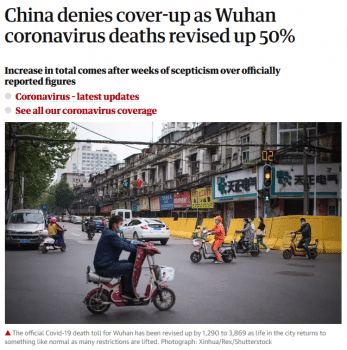
China revising its tally of coronavirus deaths was presented by the Guardian (4/17/20) as a suspicious development. Two days earlier, when New York City similarly added missed cases to its death toll, the Guardian (4/15/20) reported this as a move that would “help New York City determine the scope of the crisis.”
Countries revising their figures upon receiving new information is to be expected, and is not necessarily evidence of deceit, as plenty of nations besides China revise their data upwards. Yet only China is singled out as being exceptionally deceptive. For example, in the same week New York revised its death toll upwards by nearly 3,800, China’s adding almost 1,300 dead to its Wuhan data was presented as a possible coverup (Politico, 4/14/20; Guardian, 4/17/20). The Moon of Alabama blog (4/1/20) explained some of the complexities in reporting numbers during a pandemic in real-time:
Does one include co-morbids or not in the count? What about casualties of a car accident that also test positive for COVID-19 when they die? What about those who died with COVID-19 symptoms but could not be tested for lack of test kits? Are the tests really working reliably?… What about asymptomatic cases that test positive. Are these false positives, or do these people really have the virus? One can only know that by testing them a month later for antibodies.
Other arguments for Chinese control of the WHO cite the delay in declaring a Public Health Emergency of International Concern (PHEIC), or pandemic. A Foreign Policy op-ed (4/2/20) argued that “Beijing succeeded from the start in steering” WHO, because it was “reluctant” to declare a PHEIC. Similarly, reports in the Washington Post (2/8/20) and New York Times (4/8/20) criticized WHO for “moving too slowly in declaring a global health emergency.”
However, historian Vijay Prashad (People’s Dispatch, 4/29/20) pointed out that the U.S. and European countries were the ones that pushed to revise the rules for declaring a PHEIC or pandemic in 2005, which now requires a delay in announcement until air travel and trade wouldn’t be unduly disrupted. This means that the very same countries who are criticizing Chinese “influence” over the WHO are the ones whose actual clout was responsible for constraining WHO in the first place.
Another angle on China’s supposed manipulation of WHO are claims that China and WHO buried early Taiwanese warnings. Reuters published several reports (3/24/20, 4/11/20) claiming that the WHO “ignored Taiwan’s questions at the start of the coronavirus outbreak.” The Foreign Policy op-ed (4/2/20) on China’s control of WHO accused the agency of “ignoring warnings from Taiwanese doctors.”
This claim is based on an email the Taiwan CDC sent to WHO on December 31, presented as the smoking gun of Taipei warning WHO of human-to-human transmission, because it referred to “case hav[ing] been isolated for treatment.” However, as Beijing-based journalist Ian Goodrum pointed out on Twitter (4/11/20), China informed the WHO that same day, December 31. that “all patients are isolated.” When one actually reads the email, it’s clear that Taiwan didn’t send any warning to WHO about human-to-human transmission (which is never explicitly mentioned), and was instead, after citing Chinese sources, asking for more information.
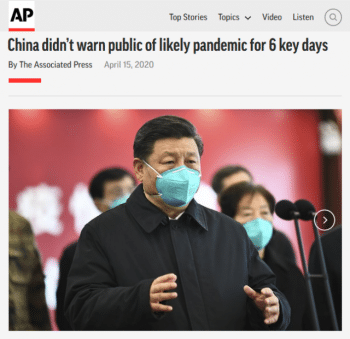
AP (4/15/20) doesn’t note that at the beginning of the “six key days,” the death toll from COVID-19 stood at one. On the sixth day, it rose from three to six.
Perhaps the most persistent false narrative of Chinese deception and concealment has nothing to do with fake statistics or Chinese manipulation of the WHO, but with China allegedly withholding details from the world and silencing whistleblowers. The Associated Press’s widely circulated report, “China Didn’t Warn Public of Likely Pandemic for Six Key Days” (4/15/20), contained many blatant falsehoods and omissions.
The AP report blamed the “delay” in informing the public between January 14 and January 20, after “top Chinese officials secretly determined they likely were facing a pandemic from a new coronavirus,” for infecting millions and killing thousands.
The AP’s claims about the Chinese government not informing the public for six crucial days are demonstrably false, as Chinese state media published multiple reports before this “crucial” period, informing the public of a “new virus” in Wuhan (China Daily, 1/9/20).
Although the AP notes that raising the alarm prematurely would damage the Chinese government’s credibility and “cripple their ability to mobilize the public,” that is not given credence as an explanation for the government “waiting” until leading Chinese epidemiologist Dr. Zhong Nanshan confirmed human-to-human transmission of COVID-19 on January 20. Instead, AP claimed that “China’s rigid controls on information, bureaucratic hurdles and a reluctance to send bad news up the chain of command muffled early warnings,” despite WHO and AP itself (1/15/20) reporting on Chinese officials warning that the possibility of human-to-human transmission could not be ruled out during this supposed period of “silence.”
An earlier AP report (3/19/20) shared a similar perspective, citing the familiar (and repeatedly debunked) myth of the Chinese government silencing Dr. Li Wenliang, a supposed “whistleblower” who warned the public of COVID-19. I previously noted (FAIR.org, 3/6/20) that Dr. Li was not a whistleblower, nor the first doctor to discover the COVID-19 outbreak, and neither was he ahead of the Chinese government. However, Vijay Prashad, Du Xiaojun and Weiyan Zhu’s timeline of the Chinese government’s response offers more clarity (People’s Dispatch, 3/31/20, 4/7/20, 4/14/20).
Dr. Zhang Jixian was the first to discover the COVID-19 outbreak, and was not a whistleblower either, because she followed established protocol by reporting it to her hospital’s disease control department on December 27. This resulted in an announcement by the Wuhan Health Commission on December 30, which is why Reuters (12/31/20) was able to report on this supposedly “secret” information in real-time.
On December 30 (the same day as the Wuhan Health Commission announcement), Dr. Ai Fen saw a test report of unidentified pneumonia, circled the words “SARS coronavirus” in red before taking a picture of it and sending it to a medical school classmate. From there, it spread in medical circles before reaching Dr. Li, who had shared it with seven colleagues in a private WeChat group on December 30 as well. Dr. Li didn’t consider himself a whistleblower, and asked them not to share the message to the public before it was leaked on December 31, the same day China notified WHO.
Dr. Li and his seven colleagues were reprimanded on January 3 (the same day China notified the U.S. CDC) for not following established protocol, as Dr. Zhang had (who was never punished, but rewarded), and for potentially causing unnecessary panic, given that the SARS-CoV-2 genomic sequence wasn’t identified and shared until January 9. While the Chinese government doesn’t pretend to have handled the outbreak perfectly—as it apologized to Dr. Li’s family and disciplined the police officers who had initially handled the case—it is hard to believe officials had a mandate to suppress knowledge of the novel coronavirus, considering nobody knew the true nature of the disease at the time.
Despite the Chinese government making much of this information readily available in their timelines, corporate media conveniently leave these crucial details out of theirs in order to advance New Cold War propaganda (Business Insider, 5/22/20; New York Times, 5/26/20).
Another example of U.S. propaganda trying to distort this history came from ABC News (4/8/20) falsely reporting (based entirely on anonymous sources) that the U.S. National Center for Medical Intelligence (NCMI) possessed a report showing that the White House was informed about the pandemic in November—suggesting that “China’s leadership knew the epidemic was out of control even as it kept such crucial information from foreign governments and public health agencies.” When the report was updated the next day, the NCMI’s director, Col. R. Shane Day, debunked this sensationalist claim, noting that “no such NCMI product exists.”
However, this manipulation of public opinion by the U.S. government and corporate media appears to be working. According to a recent Ipsos survey, more than 30% of Americans have witnessed someone blaming Asian people for the coronavirus pandemic (even though new research indicates that travel from New York City was the primary source of the U.S. outbreak, with New York’s outbreak originating in Europe). Pew Research (4/21/20) found that around two-thirds of Americans have an unfavorable view of China, which is the most negative rating for the country since Pew began asking the question in 2005. This suggests that public opinion has been turned against China, despite it being the first to detect the virus, alert the world and provide a model for containing it.

